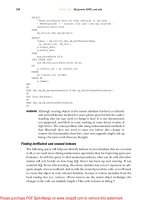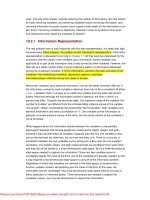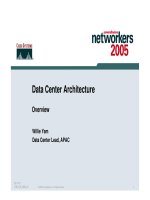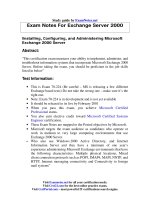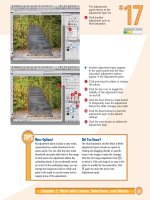Tài liệu Data Preparation for Data Mining- P12 pptx
Bạn đang xem bản rút gọn của tài liệu. Xem và tải ngay bản đầy đủ của tài liệu tại đây (316.34 KB, 30 trang )
ones. The only other answer requires reducing the number of dimensions. But that seems
to mean removing variables, and removing variables means removing information, and
removing information is a poor answer since a good model needs all the information it can
get. Even if removing variables is absolutely required in order to be able to mine at all,
how should the miner select the variables to discard?
10.2.1 Information Representation
The real problem here is very frequently with the data representation, not really with high
dimensionality. More properly, the problem is with information representation. Information
representation is discussed more fully in Chapter 11. All that need be understood for the
moment is that the values in the variables carry information. Some variables may
duplicate all or part of the information that is also carried by other variables. However, the
data set as a whole carries within it some underlying pattern of information distributed
among its constituent variables. It is this information, carried in the weft and warp of the
variables—the intertwining variability, distribution patterns, and other
interrelationships—that the mining tool needs to access.
Where two variables carry identical information, one can be safely removed. After all, if
the information carried by each variable is identical, there has to be a correlation of either
+1 or –1 between them. It is easy to re-create one variable from the other with perfect
fidelity. Note that although the information carried is identical, the form in which it is
carried may differ. Consider the two times table. The instance values of the variable “the
number to multiply” are different from the corresponding instance values of the variable
“the answer.” When connected by the relationship “two times table,” both variables carry
identical information and have a correlation of +1. One variable carries information to
perfectly re-create instance values of the other, but the actual content of the variables is
not at all similar.
What happens when the information shared between the variables is only partially
duplicated? Suppose that several people are measured for height, weight, and girth,
creating a data set with these as variables. Suppose also that any one variable’s value
can be derived from the other two, but not from any other one. There is, of course, a
correlation between any two, probably a very strong one in this case, but not a perfect
correlation. The height, weight, and girth measurements are all different from each other
and they can all be plotted in a three-dimensional state space. But is a three-dimensional
state space needed to capture the information? Since any two variables serve to
completely specify the value of the third, one of the variables isn’t actually needed. In fact,
it only requires a two-dimensional state space to carry all of the information present.
Regardless of which two variables are retained in the state space, a transformation
function, suitably chosen, will perfectly give the value of the third. In this case, the
information can be “embedded” into a two-dimensional state space without any loss of
either predictive or inferential power. Three dimensions are needed to capture the
variables’ values—but only two dimensions to capture the information.
Please purchase PDF Split-Merge on www.verypdf.com to remove this watermark.
To take this example a little further, it is very unlikely that two variables will perfectly
predict the third. Noise (perhaps as measurement errors and slightly different
muscle/fat/bone ratios, etc.) will prevent any variable from being perfectly correlated with
the other two. The noise adds some unique information to each variable—but is it
wanted? Usually a miner wants to discard noise and is interested in the underlying
relationship, not the noise relationship. The underlying relationship can still be embedded
in two dimensions. The noise, in this example, will be small compared to the relationship
but needs three dimensions. In multidimensional scaling (MDS) terms (see Chapter 6),
projecting the relationship into two dimensions causes some, but only a little, stress. For
this example, the stress is caused by noise, not by the underlying information.
Using MDS to collapse a large data set can be highly computationally intensive. In
Chapter 6, MDS was used in the numeration of alpha labels. When using MDS to reduce
data set dimensionality, instead of alpha label dimensionality, discrete system states have
to be discovered and mapped into phase space. There may be a very large number of
these, creating an enormous “shape.” Projecting and manipulating this shape is difficult
and time-consuming. It can be a viable option. Collapsing a large data set is always a
computationally intensive problem. MDS may be no slower or more difficult than any other
option.
But MDS is an “all-or-nothing” approach in that only at the end is there any indication
whether the technique will collapse the dimensionality, and by how much. From a
practical standpoint, it is helpful to have an incremental system that can give some idea of
what compression might achieve as it goes along. MDS requires the miner to choose the
number of variables into which to attempt compression. (Even if the number is chosen
automatically as in the demonstration software.) When compressing the whole data set, a
preferable method allows the miner to specify a required level of confidence that the
information content of the original data set has been retained, instead of specifying the
final number of compressed variables. Let the required confidence level determine the
number of variables instead of guessing how many might work.
10.2.2 Representing High-Dimensionality Data in Fewer
Dimensions
There are dimensionality-reducing methods that work well for linear between-variable
relationships. Methods such as principal components analysis and factor analysis are
well-known ways of compressing information from many variables into fewer variables.
(Statisticians typically refer to these as data reduction methods.)
Principal components analysis is a technique used for concentrating variability in a data
set. Each of the dimensions in a data set possesses a variability. (Variability is discussed
in many places; see, for example, Chapter 5.) Variability can be normalized, so that each
dimension has a variability of 1. Variability can also be redistributed. A component is an
Please purchase PDF Split-Merge on www.verypdf.com to remove this watermark.
artificially constructed variable that is fitted to all of the original variables in a data set in
such a way that it extracts the highest possible amount of variability.
The total amount of variability in a specific data set is a fixed quantity. However, although
each original variable contributes the same amount of variability as any other original
variable, redistributing it concentrates data set variability in some components, reducing it
in others. With, for example, 10 dimensions, the variability of the data set is 10. The first
component, however, might have a variability not of 1—as each of the original variables
has—but perhaps of 5. The second component, constructed to carry as much of the
remaining variability as possible, might have a variability of 4. In principal components
analysis, there are always in total as many components as there are original variables, but
the remaining eight variables in this example now have a variability of 1 to share between
them. It works out this way: there is a total amount of variability of 10/10 in the 10 original
variables. The first two components carry 5/10 + 4/10 = 9/10, or 90% of the variability of
the data set. The remaining eight components therefore have only 10% of the variability to
carry between them.
Inasmuch as variability is a measure of the information content of a variable (discussed in
Chapter 11), in this example, 90% of the information content has been squeezed into only
two of the specially constructed variables called components. Capturing the full variability
of the data set still requires 10 components, no change over having to use the 10 original
variables. But it is highly likely that the later components carry noise, which is well
ignored. Even if noise does not exist in the remaining components, the benefit gained in
collapsing the number of variables to be modeled by 80% may well be worth the loss of
information.
The problem for the miner with principal component methods is that they only work well
for linear relationships. Such methods, unfortunately, actually damage or destroy
nonlinear relationships—catastrophic and disastrous for the mining process! Some form
of nonlinear principal components analysis seems an ideal solution. Such techniques are
now being developed, but are extremely computationally intensive—so intensive, in fact,
that they themselves become intractable at quite moderate dimensionalities. Although
promising for the future, such techniques are not yet of help when collapsing information
in intractably large dimensionality data sets.
Removing variables is a solution to dimensionality reduction. Sometimes this is required
since no other method will suffice. For instance, in the data set of 7000+ variables mentioned
before, removing variables was the only option. Such dimensionality mandates a reduction in
the number of dimensions before it is practical to either mine or compress it with any
technique available today. But when discarding variables is required, selecting the variables
to discard needs a rationale that selects the least important variables. These are the
variables least needed by the model. But how are the least needed variables to be
discovered?
Please purchase PDF Split-Merge on www.verypdf.com to remove this watermark.
10.3 Introducing the Neural Network
One problem, then, is how to squash the information in a data set into fewer variables
without destroying any nonlinear relationships. Additionally, if squashing the data set is
impossible, how can the miner determine which are the least contributing variables so that
they can be removed? There is, in fact, a tool in the data miner’s toolkit that serves both
dimensionality reduction purposes. It is a very powerful tool that is normally used as a
modeling tool. Although data preparation uses the full range of its power, it is applied to
totally different objectives than when mining. It is introduced here in general terms before
examining the modifications needed for dimensionality reduction. The tool is the standard,
back-propagation, artificial neural network (BP-ANN).
The idea underlying a BP-ANN is very simple. The BP-ANN has to learn to make
predictions. The learning stage is called training. Inputs are as a pattern of numbers—one
number per network input. That makes it easy to associate an input with a variable such
that every variable has its corresponding input. Outputs are also a pattern of
numbers—one number per output. Each output is associated with an output variable.
Each of the inputs and outputs is associated with a “neuron,” so there are input neurons
and output neurons. Sandwiched between these two kinds of neurons is another set of
neurons called the hidden layer, so called for the same reason that the cheese in a
cheese sandwich is hidden from the outside world by the bread. So too are the hidden
neurons hidden from the world by the input and output neurons. Figure 10.3 shows
schematically a typical representation of a neural network with three input neurons, two
hidden neurons, and one output neuron. Each of the input neurons connects to each of
the hidden neurons, and each of the hidden neurons connects to the output neuron. This
configuration is known as a fully connected ANN.
Figure 10.3 A three-input, one-output neural network with two neurons in the
hidden layer.
The BP-ANN is usually in the form of a fully autonomous algorithm—often a compiled and
ready-to-run computer program—which the miner uses. Use of a BP-ANN usually
requires the miner only to select the input and output data that the network will train on, or
predict about, and possibly some learning parameters. Seldom do miners write their own
BP-ANN software today. The explanation here is to introduce the features and
Please purchase PDF Split-Merge on www.verypdf.com to remove this watermark.
architecture of the BP-ANN that facilitate data compression and dimensionality reduction.
This gives the miner an insight about why and how the information compression works,
why the compressed output is in the form it is, and some insight into the limitations and
problems that might be expected.
10.3.1 Training a Neural Network
Training takes place in two steps. During the first step, the network processes a set of
input values and the matching output value. The network looks at the inputs and
estimates the output—ignoring its actual value for the time being.
In the second step, the network compares the value it estimated and the actual value of
the output. Perhaps there is some error between the estimated and actual values.
Whatever it is, this error reflects back through the network, from output to inputs. The
network adjusts itself so that, if those adjustments were used, the error would be made
smaller. Since there are only neurons and connections, where are the adjustments made?
Inside the neurons.
Each neuron has input(s) and an output. When training, it takes each of its inputs and
multiplies them by a weight specific to that input. The weighted inputs merge together and
pass out of the neuron as its response to these particular inputs. In the second step, back
comes some level of error. The neuron adjusts its internal weights so that the actual
neuron output, for these specific inputs, is closer to the desired level. In other words, it
adjusts to reduce the size of the error.
This reflecting the output error backwards from the output is known as propagating the
error backwards, or back-propagation. The back-propagation referred to in the name of
the network only takes place during training. When predicting, the weights are frozen, and
only the forward-propagation of the prediction takes place.
Neural networks, then, are built from neurons and interconnections between neurons. By
continually adjusting its internal neuron weightings to reduce the error of each neuron’s
predictions, the neural network eventually learns the correct output for any input, if it is
possible. Sometimes, of course, the output is not learnable from the information contained
in the input. When it is possible, the network learns (in its neurons) the relationship
between inputs and output. In many places in this book, those relationships are described
as curved manifolds in state space. Can a neural network learn any conceivable manifold
shape? Unfortunately not. The sorts of relationship that a neural network can learn are
those that can be described by a function—but it is potentially any function! (A function is
a mathematical device that produces a single output value for every set of input values.
See Chapter 6 for a discussion of functions, and relationships not describable by
functions.) Despite the limitation, this is remarkable! How is it that changing the weights
inside neurons, connected to other neurons in layers, can create a device that can learn
what may be complex nonlinear functions? To answer that question, we need to take a
Please purchase PDF Split-Merge on www.verypdf.com to remove this watermark.
much closer look at what goes on inside an artificial neuron.
10.3.2 Neurons
Neurons are so called because, to some extent, they are modeled after the functionality of
units of the human brain, which is built of biochemical neurons. The neurons in an artificial
neural network copy some of the simple but salient features of the way biochemical
neurons are believed to work. They both perform the same essential job. They take
several inputs and, based on those inputs, produce some output. The output reflects the
state and value of the inputs, and the error in the output is reduced with training.
For an artificial neuron, the input consists of a number. The input number transfers across
the inner workings of the neuron and pops out the other side altered in some way.
Because of this, what is going on inside a neuron is called a transfer function. In order for
the network as a whole to learn nonlinear relationships, the neuron’s transfer function has
to be nonlinear, which allows the neuron to learn a small piece of an overall nonlinear
function. Each neuron finds a small piece of nonlinearity and learns how to duplicate it—or
at least come as close as it can. If there are enough neurons, the network can learn
enough small pieces in its neurons that, as a whole, it learns complete, complex nonlinear
functions.
There are a wide variety of neuron transfer functions. In practice, by far the most popular
transfer function used in neural network neurons is the logistic function. (See the
Supplemental Material section at the end of Chapter 7 for a brief description of how the
logistic function works.) The logistic function takes in a number of any value and produces
as its output a number between 0 and 1. But since the exact shape of the logistic curve
can be changed, the exact number that comes out depends not only on what number was
put in, but on the particular shape of the logistic curve.
10.3.3 Reshaping the Logistic Curve
First, a brief note about nomenclature. A function can be expressed as a formula, just as
the formula for determining the value of the logistic function is
For convenience, this whole formula can be taken as a given and represented by a single
letter, say g. This letter g stands for the logistic function. Specific values are input into the
logistic function, which returns some other specific value between 0 and 1. When using
this sort of notation for a function, the input value is shown in brackets, thus:
y = g(10)
Please purchase PDF Split-Merge on www.verypdf.com to remove this watermark.
This means that y gets whatever value comes out of the logistic function, represented by
g, when the value 10 is entered. A most useful feature of this shorthand notation is that
any valid expression can be placed inside the brackets. This nomenclature is used to
indicate that the value of the expression inside the brackets is input to the logistic function,
and the logistic function output is the final result of the overall expression. Using this
notation removes much distraction, making the expression in brackets visually prominent.
10.3.4 Single-Input Neurons
A neuron uses two internal weight types: the bias weight and input weights. As discussed
elsewhere, a bias is an offset that moves all other values by some constant amount.
(Elsewhere, bias has implied noise or distortion—here it only indicates offsetting
movement.) The bias weight moves, or biases, the position of the logistic curve. The input
weight modifies an input value—effectively changing the shape of the logistic curve. Both
of these weight types are adjustable to reduce the back-propagated error.
The formula for this arrangement of weights is exactly the formula for a straight line:
y
n
x a
0
+ b
n
x
n
So, given this formula, exactly what effect does adjusting these weights have on the
logistic function’s output? In order to understand each weight’s effects, it is easiest to start
by looking at the effect of each type of weight separately. In the following discussion a
one-input neuron is used so there is a single-bias weight and a single-input weight. First,
the bias weight.
Figure 10.4 shows the effect on the logistic curve for several different bias weights. Recall
that the curve itself represents, on the y (vertical) axis, values that come out of the logistic
function when the values on the x (horizontal) axis represent the input values. As the bias
weight changes, the position of the logistic curve moves along the horizontal x-axis. This
does not change the range of values that are translated by the logistic
function—essentially it takes a range of 10 to take the function from 0 to 1. (The logistic
function never reaches either 0 or 1, but, as shown, covers about 99% of its output range
for a change in input of 10, say –5 to +5 with a bias of 0.)
Please purchase PDF Split-Merge on www.verypdf.com to remove this watermark.
Figure 10.4 Changing the bias weight a moves the center of the logistic curve
along the x-axis. The center of the curve, value 0.5, is positioned at the value of
the bias weight.
The bias displaces the range over which the output moves from 0 to 1. In actual fact, it
moves the center of the range, and why it is important that it is the center that moves will
be seen in a moment. The logistic curves have a central value of 0.5, and the bias weight
positions this point along the x-axis.
The input weight has a very different effect. Figure 10.5 shows the effect of changing the
input weight. For ease of illustration, the bias weight remains at 0. In this image the shape
of the curve stretches over a larger range of values. The smaller the input weight, the
more widely the translation range stretches. In fact, although not shown, for very large
values the function is essentially a “step,” suddenly switching from 0 to 1. For a value of 0,
the function looks like a horizontal line at a value of 0.5.
Figure 10.5 Holding the bias weight at 0 and changing the input weight b
Please purchase PDF Split-Merge on www.verypdf.com to remove this watermark.
changes the transition range of the logistic function.
Figure 10.6 has similar curves except that they all move in the opposite direction! This is
the result of using a negative input weight. With positive weights, the output values
translate from 0 to 1 as the input moves from negative to positive values of x. With
negative input weights, the translation moves from 1 toward 0, but is otherwise completely
adjustable exactly as for positive weights.
Figure 10.6 When the input weight is negative, the curve is identical in shape to
a positively weighted curve, except that it moves in the opposite
direction—positive to negative instead of negative to positive.
The logistic curve can be positioned and shaped as needed by the use of the bias and
input weights. The range, slope, and center of the curve are fully adjustable. While the
characteristic shape of the curve itself is not modified, weight modification positions the
center and range of the curve wherever desired.
This is indeed what a neuron does. It moves its transfer function around so that whatever
output it actually gives best matches the required output—which is found by
back-propagating the errors.
Well, it can easily be seen that the logistic function is nonlinear, so a neuron can learn at
least that much of a nonlinear function. But how does this become part of a complex
nonlinear function?
10.3.5 Multiple-Input Neurons
So far, the neuron in the example has dealt with only one input. Whether the hidden layer
neurons have multiple inputs or not, the output neuron of a multi-hidden-node network
Please purchase PDF Split-Merge on www.verypdf.com to remove this watermark.
must deal with multiple inputs. How does a neuron weigh multiple inputs and pass them
across its transfer function?
Figure 10.7 shows schematically a five-input neuron. Looking at this figure shows that the
bias weight, a0, is common to all of the inputs. Every input into this neuron shares the
effect of this common bias weight. The input weights, on the other hand, bn, are specific
to each input. The input value itself is denoted by xn.
Figure 10.7 The “Secret Life of Neurons”! Inside a neuron, the common bias
weight (a0®MDNM¯) is added to all inputs, but each separate input is multiplied
by its own input weight (bn). The summed result is applied to the transfer function,
which produces the neuron’s output (y).
There is an equation specific to each of the five inputs:
y
n
= a
0
+ b
n
x
n
where n is the number of the input. In this example, n ranges from 1 to 5. The neuron
code evaluates the equations for specific input values and sums the results. The
expression in the top box inside the neuron indicates this operation. The logistic function
(shown in the neuron’s lower box) transfers the sum, and the result is the neuron’s output
value.
Because each input has a separate weight, the neuron can translate and move each input
into the required position and direction of effect to approximate the actual output. This is
critical to approximating a complex function. It allows the neuron to use each input to
estimate part of the overall output and assembles the whole range of the output from
these component parts.
10.3.6 Networking Neurons to Estimate a Function
Please purchase PDF Split-Merge on www.verypdf.com to remove this watermark.
Figure 10.8 shows a complete one-input, five-hidden-neuron, one-output neural network.
There are seven neurons in all. The network has to learn to reproduce the 2 cycles of
cosine wave shown as input to the network.
Figure 10.8 A neural network learning the shape of a cosine waveform. The
input neuron splits the input to the hidden neurons. Each hidden neuron learns
part of the overall wave shape, which the output neuron reassembles when
prediction is required.
The input neuron itself serves only as a placeholder. It has no internal structure, serving
only to represent a single input point. Think of it as a “splitter” that takes the single input
and splits it between all of the neurons in the hidden layer. Each hidden-layer neuron
“sees” the whole input waveform, in this case the 2 1/4 cosine wave cycles. The amplitude
of the cosine waveform is 1 unit, from 0 to 1, corresponding to the input range for the
logistic transfer function neurons. The limit in output range of 0–1 requires that the input
range be limited too. Since the neuron has to try to duplicate the input as its output, then
the input has to be limited to the range the neuron actually can output. The “time” range
for the waveform is also normalized to be across the range 0–1, again matching the
neuron output requirements.
The reexpression of the time is necessary because the network has to learn to predict the
value of the cosine wave at specific times. When predicting with this network, it will be
asked, in suitably anthropomorphic form, “What is the value of the function at time x?”
where x is a number between 0 and 1.
Each hidden-layer neuron will learn part of the overall waveform shape. Figure 10.9
shows why five neurons are needed. Each neuron can move and modify the exact shape
of its logistic transfer function, but it is still limited to fitting the modified logistic shape to
part of the pattern to be learned as well as it can. The cosine waveform has five roughly
Please purchase PDF Split-Merge on www.verypdf.com to remove this watermark.
logistic-function-shaped pieces, and so needs five hidden-layer neurons to learn the five
pieces.
Figure 10.9 Learning this waveform needs at least five neurons. Each neuron
can only learn an approximately logistic-function-shaped piece of the overall
waveform. There are five such pieces in this wave shape.
10.3.7 Network Learning
During network setup, the network designer takes care to set all of the neuron weights at
random. This is an important part of network learning. If the neuron weights are all set
identically, for instance, each neuron tries to learn the same part of the input waveform as
all of the other neurons. Since identical errors are then back-propagated to each, they all
continue to be stuck looking at one small part of the input, and no overall learning takes
place. Setting the weights at random ensures that, even if they all start trying to
approximate the same part of the input, the errors will be different. One of the neurons
predominates and the others wander off to look at approximating other parts of the curve.
(The algorithm uses sophisticated methods of ensuring that the neurons do all wander to
different parts of the overall curve, but they do not need to be explored here.)
Training the network requires presenting it with instances one after the other. These
instances, of course, comprise the miner-selected training data set. For each instance of
data presented, the network predicts the output based on the state of its neuron weights.
At the output there is some error (difference between actual value and predicted
value)—even if in a particular instance the error is 0. These errors are accumulated, not
fed back on an instance-by-instance basis. A complete pass through the training data set
is called an epoch. Adequately training a neural network usually requires many epochs.
Back-propagation only happens at the end of each epoch. Then, each neuron adjusts its
weights to better modify and fit the logistic curve to the shape of its input. This ensures
that each neuron is trying to fit its own curve to some “average” shape of the overall input
Please purchase PDF Split-Merge on www.verypdf.com to remove this watermark.

